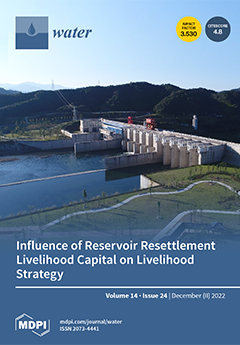Land use transformation accompanied with various human activities affects groundwater chemistry and quality globally, especially in coastal urbanized areas because of complex human activities. This study investigated the impact of land use on groundwater chemistry and quality in a coastal alluvial aquifer (CAA)
[...] Read more.
Land use transformation accompanied with various human activities affects groundwater chemistry and quality globally, especially in coastal urbanized areas because of complex human activities. This study investigated the impact of land use on groundwater chemistry and quality in a coastal alluvial aquifer (CAA) of the Pearl River Delta where urbanization continues. A fuzzy synthetic evaluation method was used to evaluate the groundwater quality. Besides, factors controlling groundwater chemistry and quality in the CAA were discussed by using a principal components analysis (PCA). Nearly 150 groundwater samples were collected. All samples were filtered on-site and stored at 4 °C until the laboratory procedures could be performed. Nineteen chemical parameters including pH, dissolved oxygen, redox potential, total dissolved solids, K
+, Na
+, Ca
2+, Mg
2+, NH
4+, HCO
3−, NO
3−, SO
42−, Cl
−, I
−, NO
2−, Pb, Mn, Fe, and As were analyzed. Results show that groundwater chemistry in the CAA was dominated by Ca-HCO
3 and Ca·Na-HCO
3 facies. In addition, groundwater with NO
3 facies was also present because of more intensive human activities. In the CAA, 61.8% of groundwaters were fit for drinking, and 10.7% of groundwaters were undrinkable but fit for irrigation, whereas 27.5% of groundwaters were unfit for any purpose. Poor-quality groundwaters in urban and agricultural areas were 1.1–1.2 times those in peri-urban areas, but absent in the remaining area. Groundwater chemistry and quality in the CAA was mainly controlled by five factors according to the PCA. Factor 1 is the release of salt and NH
4+ from marine sediments, and the infiltration of domestic and septic sewage. Factor 2 is agricultural activities related to the irrigation of river water, and the use of chemical fertilizers. Factor 3 is the industrial pollution related to heavy metals and acid deposition. Factor 4 is the input of anthropogenic reducing sewage inducing the reductive dissolution of As-loaded Fe minerals and denitrification. Factor 5 is the I
− contamination from both of geogenic and anthropogenic sources. Therefore, in order to protect groundwater quality in coastal urbanized areas, repairing old sewer systems in urban areas, building sewer systems in peri-urban areas, limiting sewage irrigation and the amount of chemical fertilizers application in agricultural areas, as well as strengthening the supervision of the industrial exhaust gas discharge in urban and peri-urban areas are recommended.
Full article





